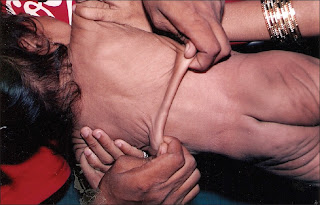Cutis laxa also known as Chalazoderma, Dermatochalasia, Dermatolysis, Dermatomegaly, Generalized elastolysis, Generalized elastorrhexis,or Pachydermatocele is a group of rare connective tissue disorders in which the skin becomes inelastic and hangs loosely in folds.
Cutis laxa is extremely rare; less than a few hundred cases worldwide have been described.
The signs of cutis laxa are very obvious, and it is usually easy to diagnose by examining the skin.
There are four genetic forms of the disease: sexlinked, autosomal dominant, and two types of autosomal recessive inheritance. The recessive forms are the most common and are usually more severe than the other forms.
1. Sex-linked cutis laxa is caused by a defective gene on the X chromosome. In addition to loose skin, its symptoms are mild mental retardation, loose joints, bone abnormalities (like hooked nose, pigeon breast, and funnel breast), frequent loose stools, urinary tract blockages, and deficiencies in lysyl oxidase, an enzyme required for the formation of properly functioning connective tissue. (But the defective gene does not code for lysyl oxidase.)
2. Autosomal dominant cutis laxa is caused by a defective gene carried on an autosomal (not sex-linked) chromosome. Its symptoms are loose, hanging skin, missing elastic fibers, premature aging, and pulmonary emphysema. Only a few families are known with cutis laxa inherited as a dominant trait.
3. Autosomal recessive cutis laxa type 1 is caused by a defective gene on chromosome 5. Symptoms include emphysema; diverticula in the esophagus, duodenum, and bladder; lax and dislocated joints; tortuous arteries; hernias; lysyl oxidase deficiencies; and retarded growth.
4. Autosomal recessive cutis laxa type 2 is also inherited as a recessive trait. In addition to the loose skin, this form of the disease is characterized by bone abnormalities, the delayed joining of the cranial (skull) bones, hip dislocation, curvature of the spine, flat feet, and excessive tooth decay.
There is no effective cure for any of these disorders. Complications are treated by appropriate specialists, for example, cardiologists, gastroenterologists, rheumatologists, and dermatologists. Plastic surgery can be helpful for cosmetic purposes, but the skin may become loose again.
The cause of acquired cutis laxa is not known, so there is no preventive measures can be taken.
Read more ...
Cutis laxa is extremely rare; less than a few hundred cases worldwide have been described.
The signs of cutis laxa are very obvious, and it is usually easy to diagnose by examining the skin.
There are four genetic forms of the disease: sexlinked, autosomal dominant, and two types of autosomal recessive inheritance. The recessive forms are the most common and are usually more severe than the other forms.
1. Sex-linked cutis laxa is caused by a defective gene on the X chromosome. In addition to loose skin, its symptoms are mild mental retardation, loose joints, bone abnormalities (like hooked nose, pigeon breast, and funnel breast), frequent loose stools, urinary tract blockages, and deficiencies in lysyl oxidase, an enzyme required for the formation of properly functioning connective tissue. (But the defective gene does not code for lysyl oxidase.)
2. Autosomal dominant cutis laxa is caused by a defective gene carried on an autosomal (not sex-linked) chromosome. Its symptoms are loose, hanging skin, missing elastic fibers, premature aging, and pulmonary emphysema. Only a few families are known with cutis laxa inherited as a dominant trait.
3. Autosomal recessive cutis laxa type 1 is caused by a defective gene on chromosome 5. Symptoms include emphysema; diverticula in the esophagus, duodenum, and bladder; lax and dislocated joints; tortuous arteries; hernias; lysyl oxidase deficiencies; and retarded growth.
4. Autosomal recessive cutis laxa type 2 is also inherited as a recessive trait. In addition to the loose skin, this form of the disease is characterized by bone abnormalities, the delayed joining of the cranial (skull) bones, hip dislocation, curvature of the spine, flat feet, and excessive tooth decay.
There is no effective cure for any of these disorders. Complications are treated by appropriate specialists, for example, cardiologists, gastroenterologists, rheumatologists, and dermatologists. Plastic surgery can be helpful for cosmetic purposes, but the skin may become loose again.
The cause of acquired cutis laxa is not known, so there is no preventive measures can be taken.
